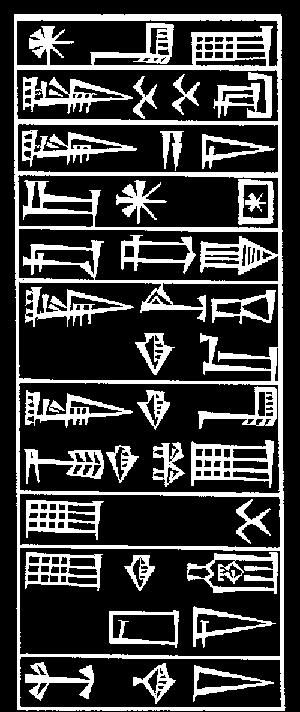This page offers a hand drawn copy of the cuneiform inscription on a stone door-pivot (German: T�rangelstein; French: crapaudine) found during the third season of excavations at Nippur, 1893-1896. According to Professor Hilprecht, its findspot was a little more than twelve meters below the surface of the mound underneath the west corner of the southeast buttress of the ziggurat (stepped tower) of Enlil.
This inscription commemorates construction work for Enlil done by King Ur-Nammu (2112-2095 B.C.), founder of the Ur III dynasty. Ur-Nammu's efforts included the innovation of building a ziggurat at Nippur for Enlil, the Sumerian high god who bestowed kingship.
You can see here the cuneiform inscription on the left and how we represent that text line by line in our Roman characters on the right. Sorry the lines do not exactly line up, but you should be able to match up the cuneiform signs with the transliteration in our alphabet.
 | den-l�l
lugal-kur-kur-ra
lugal-a-ni
ur-dnammu
nita kala-ga
lugal úrimki-ma
lugal ke-en-ge ki-uri-ke4
�-kur
� ki-�g-g�-ni
mu-na-d� |
This inscription of Ur-Nammu, king of Ur, is written in Sumerian. Rearranged into normal English order, it can be translated: Ur-Nammu, strong male, King of Ur, King of Sumer and Akkad, built for his king Enlil, king of the lands, the Ekur, his beloved temple.
If you are seeking to learn a little about the Sumerian language, look over the following notes on spelling, grammar, and vocabulary. If you have questions send Dubsar some email.
Spelling Matters
- The accent marks and subscript in the transliteration are a convention used to distinguish cuneiform signs with the same pronunciation. For example, the words "house/temple," "ditch," and "go out" were pronounced in a similar or identical fashion, but were always spelled with different cuneiform signs. So, we represent the different written signs as �, e, and �, respectively.
- The superscripts are the way we represent determinatives (word classifiers). Names of places are frequently followed by ki, occurring here after the name of the capital city of Ur. Names of deities are frequently preceded by the asterisk-looking divine symbol d.
Grammar Matters
- The word kur "land" was repeated or reduplicated to show it is plural or even a totality "all the lands."
- Sumerian does not indicate determination for nouns, that is, it has no word or construction corresponding to the English definite article "the."
- Grammatical gender, familiar to us in English (he vs. she), German (er vs. sie), and French (il vs. elle), is unknown to Sumerian. At the end of lines 3 and 8, the expression -ani represents "his," but can equally represent "her" when appropriate (as when referring to the temple of the goddess Inanna, "her temple").
- The genitive or construct relationship (English "of") is indicated by closing a as in line 2 lugal-kur-kur-ra meaning "king of the lands." It is spelled more fully ak when other elements follow as at the end of line 7 lugal ke-en-ge ki-uri-ke, "king of Sumer and Akkad" (with "a" lost after the vowel "i").
- Notice that no explicit word "and" is required, although such a word was borrowed from Akkadian.
Vocabulary Matters
- d� "to build" line 10
- � "house" used of regular houses and houses of god, that is, temples line 9
- �-kur Enlil temple in Nippur line 8
- kala "strong, mighty" line 5
- kur "land, (foreign) country" line 2
- ki-�g "beloved" also "to love" line 9
- lugal "king, lord" lines 2, 3, 6 and 7
- nita "male, man" line 5
This hand copy of the inscription is taken from H.V. Hilprecht, Old Babylonian Inscriptions Chiefly from Nippur: The Babylonian Expedition of the University of Pennsylvania, Series A, Cuneiform Texts, Philadelphia, 1893, Volume I, Part II, Text No. 121.

